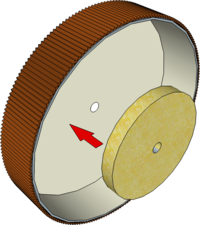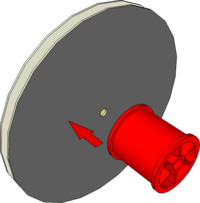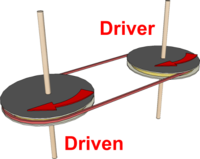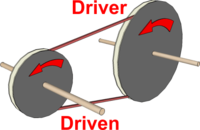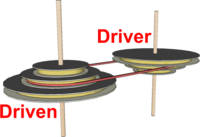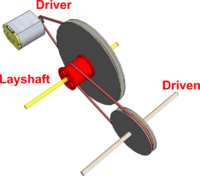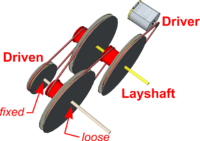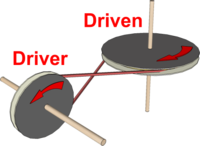Modelling Pulleys
From DT Online
Pulleys a provide a basic method of transferring motion from a motor to a model.
The Pulleys can be made using discs of card and MDF or from 'found objects' such as plastics lids, cotton reels - or even large beads.
Note: If plastics lids or cotton reels are used, card por MDF discs may have to be glued to them using Double-Sided Tape, an Adhesive such as epoxy resin or a Glue Gun since PVA will be ineffective.
Elastic bands provide suitable Drive Belts : for most purposes, use narrow ones and double them up or use several of them if a stronger belt is needed. Wide drive belts will tend to 'climb' out of the Pulley.
Making Pulleys
| Card and MDF Discs | Medium thickness card discs can be glued to each side of an MDF or Ply disc, approximately 10mm smaller in diameter, to make a grooved pulley.
In most cases PVA is a suitable glue to use (i.e. unless the card is laminated or plastics-coated in some way). |
|
| Screwtop Jar Lids | Typically found as coffee jar lids, these have a deep enough rim not to need any sides to stop the drive belt coming off.
Note: The lids are usually manufactured by a process known as Injection Moulding] and the centre can be found by looking for the small 'pip' left over from where the molten plastics was squeezed in to the mould. |
|
| Cotton Reels | The hole down the centre of cotton reeels will most likely be too big to be a tight fit on Stripwood axles and so they too may need a small MDF or Ply disc gluing on to them (most will be made of plastics so see note about gluing plastics above).
|
|
| Wooden Beads | The rounded surface of a large wooden bead can simulate the barrel-shaped pulleys once used when a single Lineshaft transferred the power from a central engine to all the machines on a factory floor.
|
Driver and Driven
| Same Size Pulleys | If two pulleys of the same diameter are fixed to two parallel shafts then the two shafts will both rotate at the same speed and in the same direction.
|
|
| Different Size Pulleys | If the two pulleys are different sizes then a smaller Driver pulley will cause a larger Driven pulley to rotate more slowly and a larger Driver pulley will cause a smaller Driven pulley to rotate more quickly.
Activity: What would happen to the speed of a 50mm Driven pulley if the Driver pulley was 100mm diameter? |
Changing Speed
| Cone Pulley | Several grooved pulleys of different diameters can be glued together in a stack as shown. Two such arrangements fixed to parallel shafts, with one upside down to the other, create a Cone Pulley drive as used in many Machine Tools.
|
|
| Double Reduction | An extra axle, known as a Layshaft can be inserted between the Driver pulley and the Driven. A loose fitting double pulley (e.g. made from a cotton reel glued to a larger grooved pulley) is allowed to rotate freely on the Layshaft.
|
|
| Multiple Reductions | The idea of using a loose fitting double pulley to enable a second speed reduction can be repeated - several times if necessary. The drive from the motor is then repeatedly transferred from small pulley to large pulley until it reaches the final Driven output pulley.
Note: Although Gears are used instead of Pulleys, the use of a Layshaft in this way is the idea around which car gearboxes are designed. |
Changing Direction
| Reverse Rotation | If the drive belt is given a half twist then the Driven pulley will rotate in the opposite diretion to the Driver pulley | |
| Changing Drive Alignment | The Driver and Driven driveshafts do not always have to be parallel to each other. Pulleys and drive belts are flexible enough to enable the two axles to be at right angles to each other for example. |

